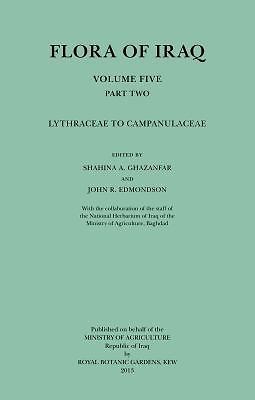
Stock photo

Stock photo
Flora of Iraq, Volume Five, Part Two : Lythraceae to Campanulaceae by John R. Edmondson (2014, Trade Paperback)

Midtown Scholar Bookstore (179521)
99.9% positive feedback
Price:
US $66.95
(inclusive of GST)
ApproximatelyS$ 87.79
+ $24.60 shipping
Returns:
30 days return. Buyer pays for return shipping. If you use an eBay shipping label, it will be deducted from your refund amount.
Condition:
Oops! Looks like we're having trouble connecting to our server.
Refresh your browser window to try again.
About this product
Product Identifiers
PublisherKEW Publishing
ISBN-101842464930
ISBN-139781842464939
eBay Product ID (ePID)166385011
Product Key Features
Number of Pages364 Pages
Publication NameFlora of Iraq, Volume Five, Part Two : Lythraceae to Campanulaceae
LanguageEnglish
Publication Year2014
SubjectLife Sciences / Botany, Life Sciences / Taxonomy
TypeTextbook
Subject AreaScience
AuthorJohn R. Edmondson
FormatTrade Paperback
Dimensions
Item Height0.9 in
Item Length9 in
Item Width6 in
Additional Product Features
Intended AudienceScholarly & Professional
Dewey Edition23
Volume NumberVol. 5, Pt. 2
IllustratedYes
Dewey Decimal581.9567
SynopsisThe Flora of Iraq is the only flora for this region in the Middle East. It enables anyone documenting, studying and/or managing Iraq's vast and rich flora to identify the vascular cryptograms and flowering plants. In addition to the detailed taxonomic information, a large amount of supplementary data of general biological interest and economic interest is provided, as well as notes on vernacular names. Nearing completion, it fills a major gap in the floral knowledge of Iraq.Full list of plant families included in Volume 5 Part 2: Lythraceae, Onagraceae, Haloragaceae, Gentianaceae, Menyanthaceae, Primulaceae, Plumbaginaceae, Plantaginaceae, Crassulaceae, Saxifragaceae, Vahliaceae, Parnassiaceae, Apiaceae (Umbelliferae), Valerianaceae, Dipsaceae, Campanulaceae., The only flora for this region in the Middle East. It enables anyone documenting, studying and/or managing Iraq's vast and rich flora to identify the vascular cryptograms and flowering plants., The Flora of Iraq is the only comprehensive reference for this region in the Middle East. It enables anyone documenting, studying, or managing Iraq's vast and rich flora to identify the vascular cryptograms and flowering plants. In addition to detailed taxonomic information, it includes general biological and economic data, as well as notes on vernacular names. As this collection nears completion, it fills a major gap in the floral knowledge of Iraq. Plant families included in Volume 5, Part 2 are Lythraceae, Onagraceae, Haloragaceae, Gentianaceae, Menyanthaceae, Primulaceae, Plumbaginaceae, Plantaginaceae, Crassulaceae, Saxifragaceae, Vahliaceae, Umbelliferae, Valerianaceae, Dipsaceae, and Campanulaceae., The Flora of Iraq is the only flora for this region in the Middle East. It enables anyone documenting, studying and/or managing Iraq's vast and rich flora to identify the vascular cryptograms and flowering plants. In addition to the detailed taxonomic information, a large amount of supplementary data of general biological interest and economic interest is provided, as well as notes on vernacular names. Nearing completion, it fills a major gap in the floral knowledge of Iraq.
LC Classification NumberQK379
Be the first to write a review



